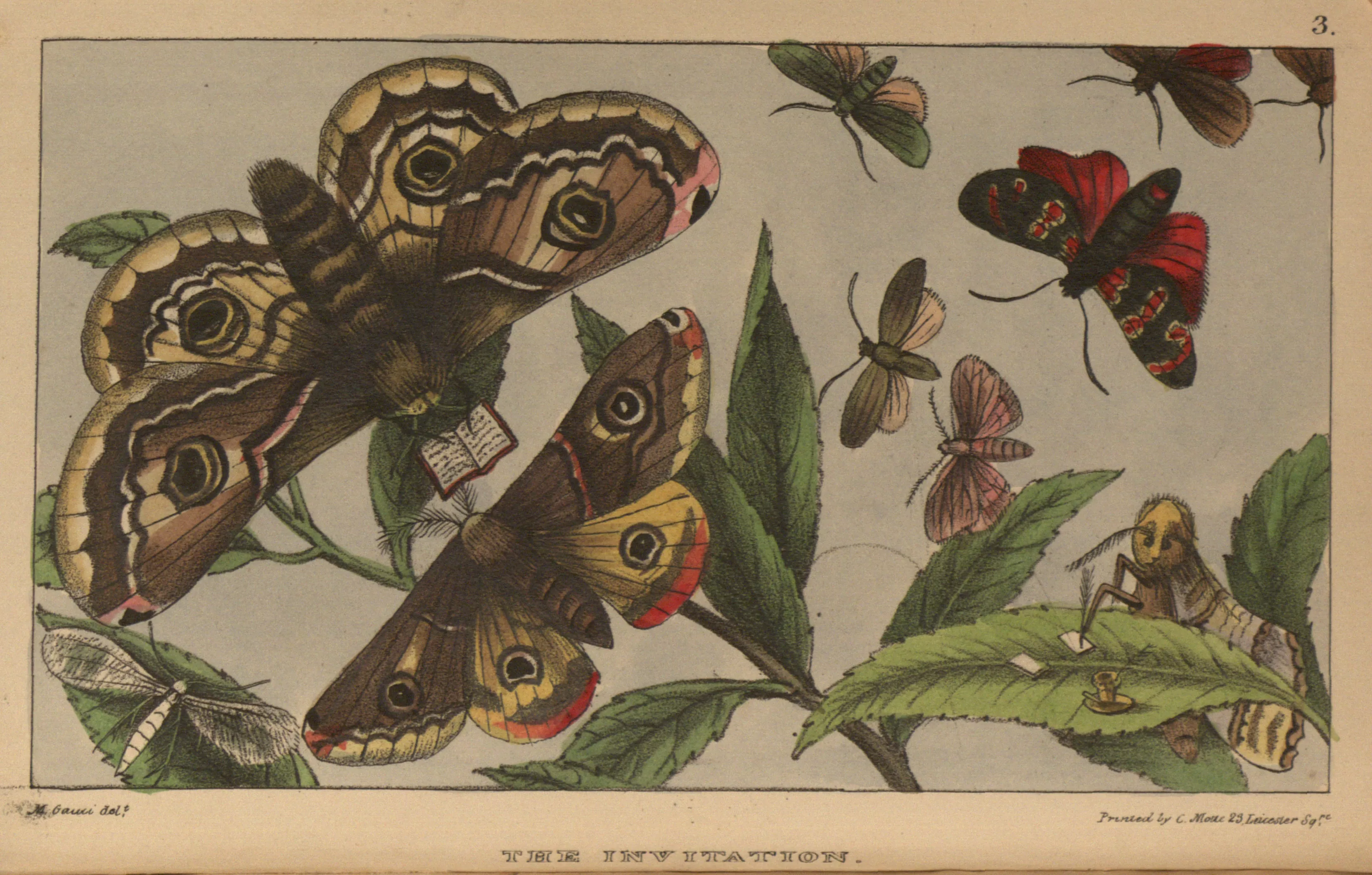Exhibit
Creation Date
1831
Height
6 cm
Width
12 cm
Medium
Description
In this image, the fantastical and the scientific are combined to make the subject matter of the accompanying text more appealing to a young audience.
The empress of the moths, a saturnia pavonia minor, perches on a leaf. She is reading her visitor's book. The emperor, a male of the same species, sits on the branch facing her. To their left, in the corner, is a small insect, reminiscent of a lacewing. In the lower right, a Buff-tip moth, or Pygæra bucephala, writes invitations with a quill pen. She sits on one leaf, and uses another as a desk. A cup of tea also rests on the leaf-desk. Above her head is a medium-sized moth, with red hindwings and black-and-red forewings, possibly a Burnet (Burton 321). To the lower left of this moth, a small pink moth and a small green-and-white moth are flying. Lack of detail makes identification impossible. Above them is another green-and-white moth. In the upper right corner, part of two brown-and-red moths can be seen.
In 1807, William Roscoe published The Butterfly’s Ball and the Grasshopper's Feast, a simple poem personifying creatures great and small. The book was immensely successful, selling 40,000 copies in its first year. Consequently, it inspired many imitations, one of which produced this illustration (MacNaughton).
The aim of this image is the same as that of the text in which it appears—to join facts about natural history with a fantastical setting (a literal moth kingdom) in order to make the included information more engaging and appealing to its young readers.
Though seen during the eighteenth century as the “poor relative” of natural philosophy because of its primarily descriptive nature, natural history had come into its own as a significant area for scientific study by 1800. Attention shifted from “a static natural history to a history of nature” (R. Yeo, “Natural Philosophy 325). Though still used as a catch-all term for the hobby of collecting and describing plants and animals, natural history now had intellectual direction as well, evidenced by its division into such subcategories as biology and comparative anatomy.
Public interest in natural history blossomed in the middle of the eighteenth century and remained strong well into the nineteenth. Adaptations of denser scientific works for the greater population, such as Oliver Goldsmith’s A History of the Earth and Animated Nature (1774), were eagerly embraced by an audience increasingly interested in the natural world (Ritvo 72). Natural history books for children began to appear in the later part of the eighteenth century, with Thomas Boreman’s A Description of Three Hundred Animals (1793) widely acknowledged as the first of its kind (73). The topic of natural history was seen as inherently attractive to young readers, consequently making it an ideal didactic and pedagogical instrument (74).
The high level of detail present in this image indicates the specificity of its two-sided goal: to entertain and educate. The image is both fanciful—moths reading and writing—and scientifically instructional, as the moth’s markings are as accurate as what would be found in an adult reference work. This combination harkens back to William Godwin’s assertion that it was crucial not to ignore the potential value of a stimulated imagination for increasing retention (W. Godwin, Bible Stories iii). Though this mixing of fantastic and fact was discouraged when the material in question was of a moral nature, this illustration is typical of the pervasive view of education: “Enlightened instructional practice, embodied in entertaining illustrated books, placed a high value on the imagination” (Stafford 70).
Locations Description
Bradbury and Evans Publishing House was begun in 1830 by William Bradbury and Frederick Muller Evans as a printing house; it later became a bookseller's as well. Though they later directed the bulk of their efforts towards legal printing and the comic magazine Punch, The Emperor’s Rout (published for Charles Tilt) was one of their first works (Shillingsburg).
Collection
Accession Number
CA 8970
Additional Information
Bibliography
Burton, Maurice and Robert Burton. “Burnet Moth.” International Wildlife Encyclopedia. 3rd ed. Tarrytown: Marshall Cavendish, 2002. 321-322. Print.
Macnaughton, Donald A. “Roscoe, William (1753–1831).” Oxford Dictionary of National Biography. Ed. H. C. G. Matthew and Brian Harrison. Oxford: OUP, 2004. Web. 1 May 2009.
Patten, Robert L. and Patrick Leary. "Bradbury, William (1800–1869)." Oxford Dictionary of National Biography. Ed. H. C. G. Matthew and Brian Harrison. Oxford: OUP, 2004. Web. 1 May 2009.
Shillingsburg, Peter. "Bradbury and Evans." Victorian Web. Web. April 4 2009.
Ritvo, Harriet. “Learning from Animals: Natural History for Children in the Eighteenth and Nineteenth Centuries.” Children’s Literature 13 (1985): 72-93. Print.
Stafford, Barbara Maria. Artful Science: Enlightenment Entertainment and the Eclipse of Visual Education. Cambridge, MA: MIT P, 1993. Print.

